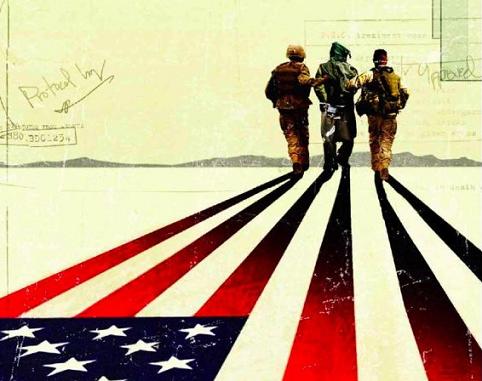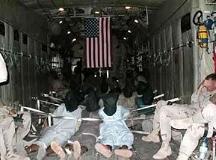This past week, I had the opportunity to check out the Oscar-winning detainee torture documentary Taxi to the Dark Side.
The film was written and directed by Alex Gibney, of Enron: The Smartest Guys in the Room and Who Killed the Electric Car? fame.
Taxi‘s title refers to a young Afghan cab driver named Dilawar, whose plight was made public several years ago in a series of articles written by Tim Golden for the New York Times.
Shortly after picking up a fare in the eastern province of Khost, Dilawar was stopped by Afghan militiamen at a checkpoint. He and the three men he was chauffeuring were accused of being responsible for rocket attacks on an American army base in the region.
With nothing more than the word of the militiamen as evidence against them, the four were handed over to the American forces at Bagram detention center.
The men were questioned by poorly-trained interrogators that were given deliberately vague guidelines as to the kinds of techniques that they were allowed to employ.
Dilawar was handcuffed and chained to the ceiling of his small cell in a standing position, so that he could not fall asleep. The sleep deprivation was aimed at making him more pliable during interrogation.
The guards at Bagram believed they were explicitly authorized to use force to control detainees. It was thought that they were not allowed to strike the prisoners above the waist, but they were allowed to deliver strikes to pressure points in the legs in order to facilitate compliance. Guards were not impressed with Dilawar’s cries and pleas for help. They would take turns kneeing him in the thigh until they grew tired.
“He screamed out, ‘Allah! Allah! Allah!’ and my first reaction was that he was crying out to his god,” Specialist Jones said to investigators. “Everybody heard him cry out and thought it was funny.”
Other Third Platoon M.P.’s later came by the detention center and stopped at the isolation cells to see for themselves, Specialist Jones said.
It became a kind of running joke, and people kept showing up to give this detainee a common peroneal strike just to hear him scream out ‘Allah,’ ” he said. “It went on over a 24-hour period, and I would think that it was over 100 strikes.”
(Source: New York Times)
After five days of torture, Dilawar died. He was killed by heart failure due to “blunt force injuries to the lower extremities.” The army pathologist who examined him ruled his death a homicide.
the tissue in the young man’s legs “had basically been pulpified.”
“I’ve seen similar injuries in an individual run over by a bus,” added Lt. Col. Elizabeth Rouse, the coroner, and a major at that time.
(Source: New York Times)
When public scrutiny finally fell on the case several years after Dilawar’s death, the military was forced to lay charges. The toughest sentence imposed for the torture and murder of Dilawar was 5 months. Two of the soldiers responsible received sentences of two and three months, respectively. None of the other guards who were convicted in the Dilawar case received any jail time at all. Furthermore, to my knowledge, none of the officers giving the orders, let alone the administration officials who drafted the policies permitting detainee abuse, were ever prosecuted.
Since detainees were denied the fundamental right of habeas corpus, they had no way to challenge their detention. It was later discovered that the Afghan militia leader who turned the four men over to U.S. authorities had himself been launching rockets at the American base. He had been arresting and turning in innocent Afghan civilians to curry favour with the Americans.
Even more frightening, it was later discovered that Dilawar’s captors believed he was innocent from the start:
“Most of the interrogators had believed Mr. Dilawar was an innocent man who simply drove his taxi past the American base at the wrong time.”
(Source: New York Times)
The three occupants of Dilawar’s car were eventually released; it was of course too late for Dilawar.
He was one of the first prisoners to die in U.S. custody since the beginning of the War on Terror. He would not be the last.
While the taxi driver’s tragic tale sets the stage for the film, it is not the central focus. Dilawar becomes the anchor of a story that takes us all around the world from Bagram detention center in Afghanistan, to Abu Ghraib prison in Iraq, to Guantanamo Bay in Cuba, and finally all the way up the chain to the Oval Office in Washington.
Taxi to the Dark Side persuasively argues that the atrocities at Abu Ghraib and elsewhere were not the product of a “few bad apples.” Rather, the policies and attitudes that led to detainee abuse were implicitly and sometimes explicitly authorized at the highest levels of the Bush administration.
While the story has certainly been told before, Gibney has a talent for piecing it together succinctly and logically. That, coupled with the fact that the director managed to actually score interviews with Dilawar’s interrogators and abusers, makes this documentary an absolute standout.
I would highly recommend this film to anyone interested in the subjects of criminal law, the “war on terror,” war crimes and atrocities, and international law. While I think that any lay person with even cursory interest in the above subjects would find it disturbing, thought-provoking, and fascinating, the law student will appreciate it on a deeper level.



Lawrence, a great review of an excellent documentary.